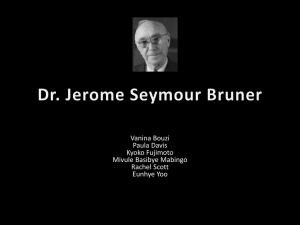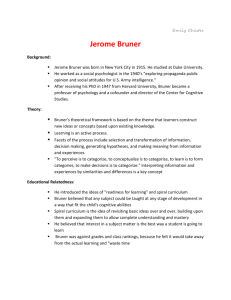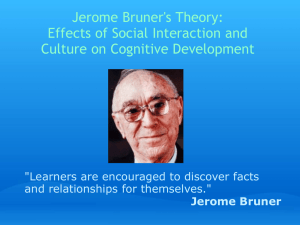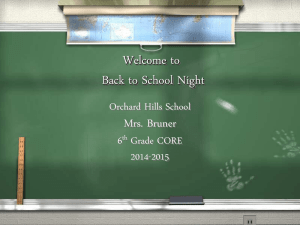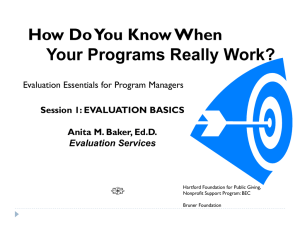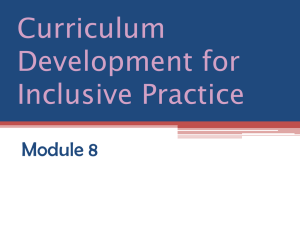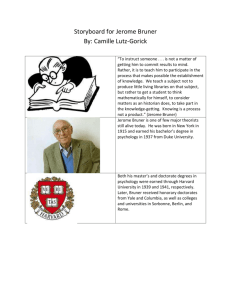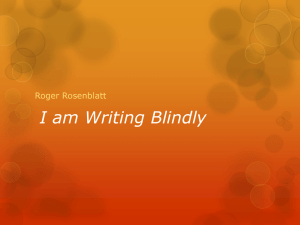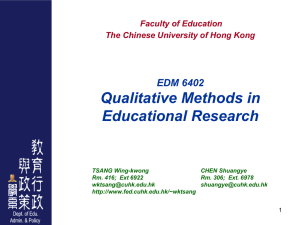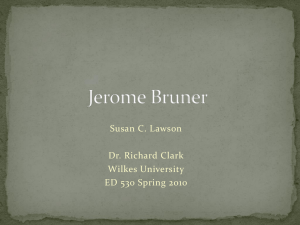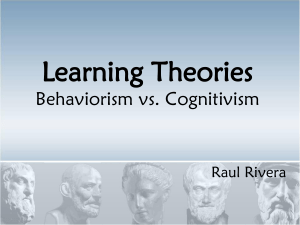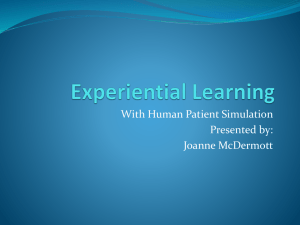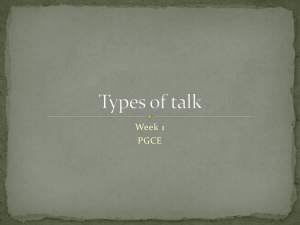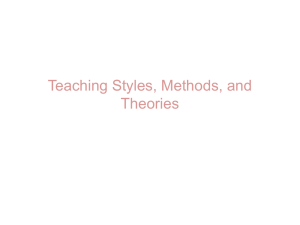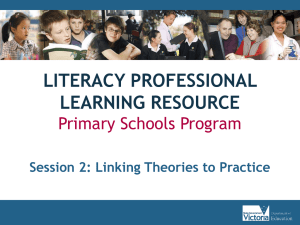Jerome Bruner
advertisement
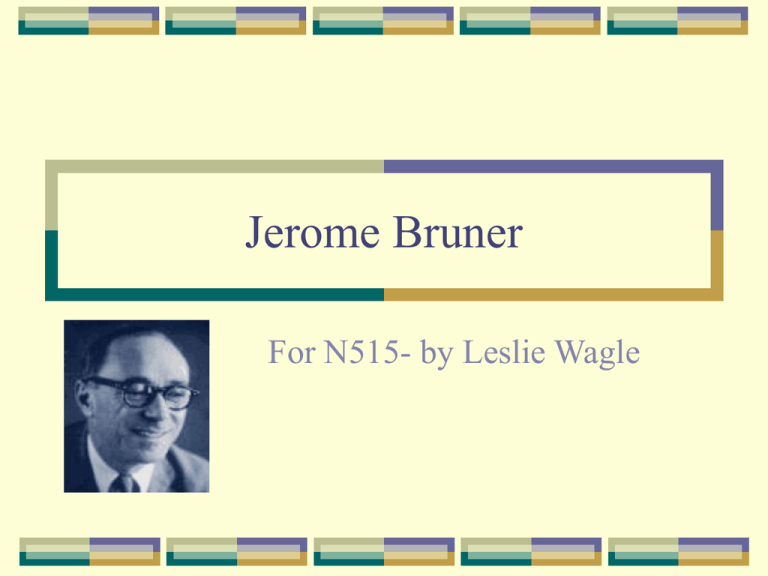
Jerome Bruner For N515- by Leslie Wagle Life Jerome Bruner was born in New York City and educated at Duke University and Harvard. His career has been long and productive, including leadership roles in several landmark projects that had widespread influence on education practices. He began studying the cognitive development of children in the 1940’s and became interested in schooling in the USA in the 1950’s. In the 1960’s he suggested that intellectual ability developed in stages though stepped changes in how the mind is used. In the 1980’s he began to believe that cultural influences affect learning psychology. Key Concepts • • Bruner believed that detailed material is remembered by the use of simplified ways of representing it. He deplored the educational psychology dominant in America before 1940, which confused "skills" with "understanding." Instead, Bruner placed "structure" at the heart of education: give a child a sense of the structure of what he is being taught and he will learn the information for himself. To instruct someone is not a matter of just getting things into his mind, but teaching him to participate in the process of gaining knowledge.” Effect on American Education Jerome Bruner is now widely regarded as one of the most influential twentieth century writers and thinkers to apply principles of psychology to modern education and curriculum theory. Bruner claimed that any subject can be taught effectively in some form to any child at any stage of development. A curriculum should revisit basic ideas repeatedly, building on them until the student has grasped the general picture in terms of the relationships between things encountered earlier and later. His main theories Jerome Bruner was among the first to realize that ("thinking") depends on placing an event or situation in the appropriate category. Bruner also realized that categories are not "discovered" but "invented". They do not exist in the environment: they are construed by the human mind. Thus what matters is really the classifying information into a new category, or which into some existing category. Three principles of his overall thinking are readiness, structure and sequence, and extrapolation. Readiness • Instruction must be concerned with the experiences and contexts that make the student willing and able to learn. • So, a teacher might first excite interest by filling a glass with water and asking students how many pennies they think can be put into the jar without water spilling out. Their curiosity would be aroused when the pennies greatly exceed their estimates. This then leads to an exploration of many variables and basic principles they would find perplexing if offered only in theory. Structure • • Instruction must be structured so that it can be easily grasped by the student. Bruner demonstrated that any domain of knowledge, or problem or concept, can be represented in some way (including images or graphics) simple enough that any particular learner can understand it in a recognizable form. Sequence • Instruction should lead the learner through the content in order to increase the student’s ability to grasp, transform, and transfer what is learned. In general, sequencing should move from hands-on concrete experiences, to iconic (visual) then to symbolic. Extrapolation • Instruction should be designed to facilitate filling in the gaps (going beyond the information given). • The nature and pacing of instruction should move away from external rewards, such as a teacher’s praise, toward the intrinsic rewards inherent in solving problems or understanding concepts. The teacher can provide a vital link to the learner in helping the learner develop techniques for obtaining feedback on his or her own. Application of the Theories Bruner introduced the doctrine of the spiral curriculum, that all topics -in some form -must be introduced at an early age, but cannot be exhausted at any age, and thus must be returned to in increasing depth. The Spiral In order for a student to develop from simple to more complex lessons, certain basic knowledge and skills must first be mastered. This provides linkages between each lesson as student spirals upwards in a course of a study. As new knowledge and skills are introduced, they reinforce what is already learned and become related to previously learned information. What the student gradually achieves is a rich breadth and depth of information that is not normally developed when each topic is discrete and disconnected from each other. Legacy • • A constant theme in Bruner’s work is that education is a process of discovery. Students are encouraged to discover facts and relationships for themselves and continually build on what they already know. This has greatly influenced teaching styles, such as where the teacher does not just talk about dinosaurs, but has the students construct models of dinosaurs, watch a film about them, and then discuss imaginary encounters with them, etc. He also was an influence on the Xerox researchers in their efforts to create the graphic user interface (GUI). Latest Interests Bruner has begun to promote the insight that “we construct and we reconstruct our world, not just with bricks and mortar, but by creating and re-creating the meaning of different things.” This process takes place largely through social interaction, where the role of culture is key to shaping the concept we have of ourselves and our powers. How Bruner relates to Music In 1991 Bruner published an article entitled “The narrative Construction of Reality” in which he argued that the mind structures its sense of reality through symbolic systems. The narrative idea has been used by one music educator. • The following material is taken from an article in Piano Pedagogy Forum by Ivan Frazier http://www.music.sc.edu/ea/ keyboard/PPF/4.2/4.2PPFpp.html Frazier explains an experience where he described a piece by Bach in narrative rather than technical terms. “I might have described the piece this way: In three-eight meter the subject begins with the right hand in the tonic key followed by its imitation by the left hand in the dominant, as the right hand takes the countersubject over from the left hand. Then the right hand repeats the subject in D-sharp minor, the subdominant of the relative minor. Continuing the process the left hand imitates the subject etc., etc., etc.” But, Frazier didn’t think it that would provoke much excitement or interest in the piece, so during his lecture “I said it was lively and frolicsome due its three-eight meter and that the left hand chases the right through a maze of related major and minor keys.” “Narrative thinking and language like that can awaken curiosity and fascination, which can generate the energy needed to find out what it means that the left hand chases the right, and to explore that maze of related keys to see where it leads with all its turns and cadences along the way. Students may then find the motivation to do the hard work needed for objective analysis and diligent practice.” One student assigned characters, as in a drama, to all the themes in the final rondo of a Mozart Sonata, and made a simple visual representation of each character. Her "map" acted as an operatic narrative and a useful tool for secure memorization of the movement. Ivan Frazier has had success with asking his piano students to relate to a problem by finding a narrative for it. He finds that they often improve their playing when he asks them to find a more global concept. One student described pedaling problems as “It sounds like a change from 'stereo' to 'mono’” Another one said that ritenuto is when you "hit traffic." Frazier concludes: “I have found myself increasingly alert to statements from, and incidents with students that show evidence of narrative thinking, and have started a diary to collect them.” In closing…. Jerome Bruner, whose career spans more than 60 years, was not happy with the early use of computers (for drill and practice) in schools. Although he is happy with later efforts to stimulate intuitive and analytical thinking, Bruner still thinks technology has not explored the spiral curriculum concept in its full potential to create knowledge students can build on. http://edtech2.boisestate.edu/wagnerk/edtech580/jerome.htm 1. 2. 3. 4. (4) 5. 6. References (picture) http://www.doyletics.com/arj /tpoerev.htm Smith, M.K. http://www.infed.org/thinkers /bruner.htm Raimi, Ralph http://www.math.rochester.e du/people/faculty/rarm/brune r.html Sherwood, Emily http://www.educationupdate. com/archives/2005/Nov/html /col-jeromebutler.html Smith, M.K. http://www.infed.org/thinkers /bruner.htm Scaruffi, Piero. http://www.thymos.com/min d/bruner2.html Smith, M.K. http://www.scied.gsued.edu/ Hassard/mos/2.7html 7. 8. 9. 10. 11. 12. 13. 14. Kinnes, T. http://oaks.nvg.org/wm1ra2.h tml Hassard, Jack http://www.scied.gsued.edu/H assard/mos/2.7html Hassard, Jack http://www.scied.gsued.edu/H assard/mos/2.7html Raimi, Ralph http://www.math.rochester.ed u/people/faculty/rarm/bruner. html Kristinsdottir, S. http://www.starfsfolk.khi.is/so lrunb/jbruner.htm_3.htm Hollyman, David http://au.geocities.com/vanun oo/Humannature/bruner.html Scaruffi, Piero. http://www.thymos.com/mind /bruner2.html -http://en.wikipedia.org/wiki/J erome_Bruner
